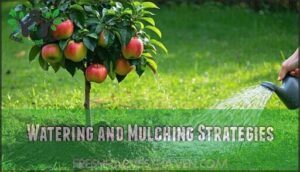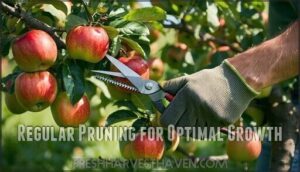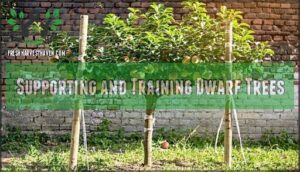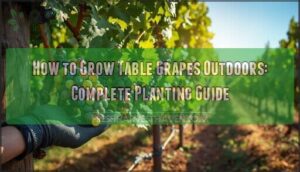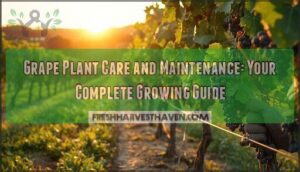This site is supported by our readers. We may earn a commission, at no cost to you, if you purchase through links.
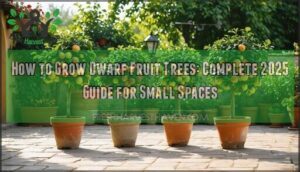
You’ll need containers at least 20 gallons with drainage holes, quality potting mix, and 6-8 hours of daily sunlight.
Plant your tree at the same depth it grew in the nursery, then establish a consistent watering schedule that keeps soil moist but not waterlogged.
Apply balanced fertilizer monthly during growing season and prune in late winter to maintain shape and encourage fruiting.
Most dwarf varieties produce fruit within 2-3 years, and the secret lies in understanding rootstock selection and specialized training techniques.
Table Of Contents
- Key Takeaways
- Growing Dwarf Fruit Trees
- How to Grow Dwarf Trees
- Dwarf Tree Care Techniques
- Container Gardening Tips
- Advanced Dwarf Tree Growth Methods
- Frequently Asked Questions (FAQs)
- How long does it take to grow a dwarf fruit tree?
- What is the disadvantage of a dwarf fruit tree?
- Can dwarf fruit trees stay in pots?
- What are the easy to grow dwarf fruit trees?
- What pests commonly affect dwarf fruit trees?
- How to encourage faster fruit production?
- Are dwarf fruit trees suitable for hydroponics?
- Can multiple varieties grow on one dwarf tree?
- When is the best season to plant dwarf trees?
- How long before dwarf fruit trees produce fruit?
- Conclusion
Key Takeaways
- Choose the right container and location – You’ll need at least a 20-gallon container with drainage holes and 6-8 hours of daily sunlight for your dwarf fruit trees to thrive and produce quality yields.
- Master your watering and fertilization schedule – Keep the soil consistently moist but not waterlogged, and apply a balanced fertilizer monthly during the growing season to support healthy growth and fruit production.
- Prune regularly for maximum productivity – You should prune in late winter to maintain shape and encourage fruiting, as proper pruning techniques can significantly boost your harvest yield.
- Plan for quick results with proper care – Most dwarf varieties will start producing fruit within 2-3 years when you provide consistent care, proper rootstock selection, and appropriate training techniques.
Growing Dwarf Fruit Trees
You can grow dwarf fruit trees successfully in small spaces by selecting varieties suited to your climate and soil conditions.
These compact trees need proper soil preparation, adequate sunlight, and the right container size to produce healthy fruit yields.
Choosing The Right Tree Variety
Before choosing dwarf fruit trees, consider your climate zone and space constraints.
Select self-fertile trees like Meyer lemons or figs if you lack room for multiple varieties.
Match rootstock selection to your soil conditions—some perform poorly in wet clay.
Consider fruit preference and maintenance needs when evaluating different fruit tree varieties for your small space garden.
Many varieties are available that are suitable for containers, making them ideal for limited spaces.
Preparing The Soil and Container
Well-draining soil mixed with compost enrichment creates the foundation for thriving dwarf fruit trees.
Test your soil pH and adjust it between 6.0-7.0 for ideal nutrient uptake. Choose containers with proper drainage holes and fill them with quality potting mix.
Add slow-release fertilizer types that match your rootstock compatibility needs for successful container gardening and long-term fruit tree care. Terracotta pots offer excellent drainage and breathability, preventing root rot.
Understanding Sunlight and Temperature Requirements
Your dwarf fruit trees need proper sunlight and temperature conditions to thrive and produce quality fruit.
Give your dwarf trees the sunlight they crave—6-8 hours daily makes all the difference between struggling plants and abundant harvests.
Most dwarf varieties require these growing conditions:
- Sunlight Duration: Provide 6-8 hours of direct sunlight daily for ideal photosynthesis and fruit development
- Temperature Tolerance: Choose varieties suited to your hardiness zone, as cold sensitivity varies between apple, citrus, and stone fruits
- Cold Protection: Shield young trees from frost using covers or relocating containers to protected areas during winter
Understanding your local microclimates helps you position trees strategically.
South-facing locations typically offer maximum sun exposure and warmth for consistent growth.
How to Grow Dwarf Trees
Growing small fruit trees in your backyard requires understanding key fundamentals that determine success. Start by selecting the right rootstock for your climate and soil conditions. This foundation controls your tree’s size and disease resistance.
Here are three essential steps for growing dwarf trees:
- Choose disease-resistant varieties suited to your hardiness zone
- Plant in well-draining soil with proper depth and spacing
- Establish consistent watering schedules during the first growing season
Fertilization needs vary by tree type but generally require balanced nutrients in spring. Most compact fruit trees need protection from strong winds and extreme temperatures. Winter protection becomes essential in colder regions where frost can damage branches and buds.
Your backyard orchard will produce fruit within 2-3 years when properly established. Tree pruning starts early to shape growth patterns. Effective pest control prevents common issues like aphids and scale insects. Harvesting tips include picking fruit at proper ripeness for best flavor and storage life.
Dwarf Tree Care Techniques
Once you’ve planted your dwarf fruit tree, proper care becomes the key to long-term success.
These compact trees need specific attention to watering, pruning, and support to reach their full potential.
Watering and Mulching Strategies
Your watering schedule makes or breaks root health in compact fruit trees.
Water young dwarf trees with 3-5 gallons twice weekly, targeting the drip line rather than the trunk.
Check soil moisture 6-12 inches deep with a trowel.
Apply organic mulch types like wood chips around the base for water conservation and temperature control.
Consider suitable options for trees to enhance growth.
Regular Pruning for Optimal Growth
Annual pruning sessions transform your dwarf fruit trees into productive powerhouses.
Cut new shoots by half during summer months.
This size control method encourages branching while maintaining manageable tree shape.
Focus pruning techniques on removing dead wood and water sprouts.
Regular cuts boost fruit yield by directing energy toward quality fruit production rather than excessive plant growth.
Pruning helps guarantee proper sunlight penetration to lower branches, ensuring a healthy and manageable tree shape with quality fruit production and proper sunlight penetration.
Supporting and Training Dwarf Trees
While young trees establish their root systems, proper support prevents wind damage and guarantees straight growth.
Install sturdy stakes within the first year using flexible ties that won’t restrict trunk movement.
Train branches to ideal angles using spreaders or weights—45-degree angles maximize fruit tree yield.
To maximize fruit production, consider hand-pollination techniques.
Choose training systems like espalier or central leader based on your space and growth habit preferences for best fruit tree size control.
Container Gardening Tips
Container gardening transforms any space into a productive fruit-growing area, making dwarf trees accessible even for apartment balconies and small patios.
You’ll discover that containers offer precise control over soil conditions, drainage, and placement while simplifying maintenance tasks throughout the growing season.
Selecting The Right Container and Soil
Container size makes all the difference for your dwarf fruit trees’ success. Choose 15-20 gallon containers with multiple drainage holes to prevent waterlogged roots.
The right container size determines whether your dwarf fruit tree thrives or struggles.
Your soil composition should include organic amendments like compost and maintain proper soil pH between 6.0-7.0. You can also improve drainage by ensuring proper drainage holes are present.
- Freedom to move: Containers let you relocate trees for ideal sunlight requirements
- Perfect soil control: You decide the exact soil preparation your tree needs
- Space efficiency: Maximize small areas without compromising fruit tree size
Benefits of Container Gardening for Dwarf Trees
When you choose container gardening, you’re releasing portability benefits that let you move trees for ideal sunlight requirements and weather protection.
Space optimization becomes your superpower as you control tree spacing without yard limitations. You gain complete soil control for disease prevention and proper soil preparation.
Consider using specialized dwarf fruit containers for best results. Plus, elevated containers improve pest control while promoting early fruiting through better drainage and root management.
Common Challenges and Solutions for Container Growing
While container growing offers flexibility, you’ll face drainage issues that lead to root rot.
Check soil moisture regularly and make certain proper drainage holes.
Root bound trees struggle in small containers—repot every 2-3 years.
Nutrient deficiency shows through yellowing leaves, requiring regular fertilization.
Consider using specialized dwarf fertilizer for ideal growth.
Implement pest control measures and disease prevention strategies.
Overwintering requires protection from freezing temperatures and proper tree spacing prevents overcrowding issues.
Advanced Dwarf Tree Growth Methods
Once you’ve mastered basic dwarf fruit tree care, you can explore specialized techniques that maximize productivity in minimal space.
These advanced methods include espalier training, multi-grafting options, and strategic planting arrangements that can triple your harvest from the same footprint.
Espalier and Hedgerow Planting Techniques
Training your dwarf trees through espalier transforms ordinary branches into living works of art.
Epalier training creates flat, decorative patterns against walls or fences while maximizing fruit yield in tight spaces.
Proper hedgerow spacing allows trees to form productive barriers.
Strategic pruning methods shape branches horizontally for ideal sunlight exposure throughout the canopy, boosting horticulture success in small gardens.
To achieve the best results, understanding wood type for fruiting is essential.
Multi-Grafting and Customization Options for Dwarf Trees
Multi-grafting transforms your dwarf trees into living fruit salad bars.
You can graft up to six varieties on one rootstock, creating custom tree shapes with diverse harvests.
Grafting benefits include extended seasons and disease resistance through careful scion compatibility matching.
Professional horticulture techniques let you hybridization different fruits while rootstock selection controls size.
This advanced tree training maximizes your small space investment, allowing for custom tree shapes and diverse harvests.
Maximizing Space and Yield With Dwarf Fruit Trees
Ideal spacing releases remarkable yields from dwarf fruit trees in small gardens.
Strategic pollination strategies and microclimate optimization transform compact spaces into productive orchards.
- Plant trees 18-24 inches apart for maximum sunlight exposure and efficient nutrients distribution
- Select compatible rootstock for your soil type while considering fertilization needs and pest control requirements
- Implement systematic tree training through pruning techniques that direct energy toward fruit production
- Create microclimates using reflective mulches and windbreaks to extend growing seasons naturally
Frequently Asked Questions (FAQs)
How long does it take to grow a dwarf fruit tree?
Like a patient gardener watching seeds transform, you’ll typically wait 2-4 years for your dwarf fruit tree to produce its first harvest.
Though some varieties reward you sooner with proper care.
What is the disadvantage of a dwarf fruit tree?
Dwarf fruit trees produce smaller yields than standard trees, have shorter lifespans, and require more frequent watering.
You’ll also need specialized rootstock and face limited variety options compared to full-sized trees.
Can dwarf fruit trees stay in pots?
Yes, dwarf fruit trees thrive in pots. You’ll need containers that hold 15-20 gallons with excellent drainage. They’re perfect for patios and small spaces while still producing delicious fruit.
What are the easy to grow dwarf fruit trees?
Like finding the sweet spot in a garden, certain dwarf varieties thrive with minimal fuss.
You’ll find apples, pears, and cherries are beginner-friendly choices.
Figs and citrus trees adapt well to containers and forgive occasional care mistakes.
What pests commonly affect dwarf fruit trees?
You’ll face apple maggots, aphids, codling moth, plum curculio, San Jose scale, plus trunk borers particularly threatening young trees and mice and voles damaging bark. Monitor regularly for early detection.
How to encourage faster fruit production?
Maximize sunlight exposure to 8+ hours daily. Apply balanced fertilizer during growing season. Prune regularly to redirect energy toward fruit development. Choose self-fertile varieties and make certain proper watering without overwatering.
Are dwarf fruit trees suitable for hydroponics?
Like planting seeds in a tech garden, dwarf varieties thrive exceptionally well in hydroponic systems due to their compact size and container-friendly growth requirements.
You’ll need adequate lighting and proper nutrient management for success.
Can multiple varieties grow on one dwarf tree?
Grafting lets you grow multiple fruit varieties on one dwarf tree.
You can combine apples, pears, or stone fruits through careful grafting techniques.
Each branch produces different fruit while sharing the same rootstock system.
When is the best season to plant dwarf trees?
Picture a seed sleeping through winter’s harsh embrace, awakening when spring’s gentle warmth whispers promises.
You should plant dwarf trees in early spring through May when soil becomes workable and dormancy breaks, or fall for ideal establishment before winter.
How long before dwarf fruit trees produce fruit?
Most dwarf fruit trees start producing fruit 2-3 years after planting, though some may take up to 4 years. Your patience pays off with compact, manageable harvests perfect for small spaces.
Conclusion
Research shows that dwarf fruit trees can produce up to 75% of the yield of full-sized trees while using just 25% of the space.
Successfully learning how to grow dwarf fruit trees requires patience and consistent care.
Your trees will reward proper container selection and regular pruning with years of fresh fruit production.
Remember that most varieties begin producing within 2-3 years, and with the right rootstock and training techniques, you’ll maximize your harvest in minimal space.
- https://www.southernliving.com/garden/trees/dwarf-fruit-trees
- https://www.youtube.com/watch?v=vCdic41aUhw
- https://www.reddit.com/r/BackyardOrchard/comments/1j2ashe/best_way_to_grow_dwarf_fruit_trees_in_wet_clay/
- https://abundantminigardens.com/dwarf-fruit-trees/
- https://www.growveg.com/plants/us-and-canada/how-to-grow-dwarf-fruit-trees/

